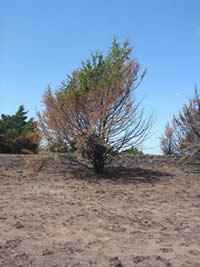
National Fire Plan Success Story
Arson Task Force Successful on Oklahoma BIA Lands
A severe drought gripped much of Oklahoma in the fall of 2005. This drought continued through the winter, spring and summer of 2006. As is typical of drought in the Southern Plains, this drought was accompanied by extreme wildfire activity. In addition to the loss of timber and hay crops, the wildfires killed livestock, destroyed homes and property and resulted in fatalities. Unfortunately, many of these fires were the work of arsonists.
One area with an unusually high incidence of arson was Caddo and Canadian counties in southwestern Oklahoma. Arson activity in this area persisted throughout the spring and early summer with an average of 10 arson fires involving trust lands being reported each week. While actual damage on trust lands was minimal, the potential for extensive damage or loss of life was very real. Due to this threat, Rod Robertson, the Bureau of Indian Affairs, Southwest Oklahoma Zone Fire Coordinator requested an arson task force team be established.

Example of macro indicators used to identify the general origin area.
The task force team, consisting of an NWCG certified Wildland Fire Investigator, two trainee fire investigators and a fire prevention technician arrive on July 31. They began their investigations by visiting the scenes of wildfires that had occurred over the previous weekend and meeting with various law enforcement and fire department officials. Contacts were made at rural stores seeking information about the arson activity. All informants were encouraged to use WeTIP to report any information. The WeTIP program posters and signs were posted at the scenes of fires occurring on trust lands as well as local stores and fire departments. At the same time, the state of Oklahoma implemented a ban on outdoor burning covering the entire state, and coincidentally initiated a separate investigation into arson activity in Canadian county.
The combined effect of all this attention was dramatic. Not only did arson activity nearly cease, but overall wildfire activity in the two counties was dramatically reduced following the arrival of the task force. Only four wildfires were reported in these counties during the two weeks the task force was in place. Two of these were arson, however neither of these impacted trust lands. Fire danger actually increased throughout the two week time period that the task force was present with daily temperatures reaching 102 to 108, and relative humidity reported in the low 20% range.
The dramatic reduction in the number of wildfires even though fire danger continued to increase demonstrates the impact an arson task force team can have in arson prone areas. In Oklahoma, where arson is an ongoing problem, the intervention of a task force team reduced the possibility of damage from wildfire to the lives and property of the residents.
Contact: Patrick McDowell, BIA WUI/Prevention Specialist, Eastern Oklahoma and Southern Plains Regions, 405-609-8872